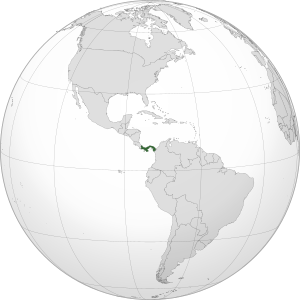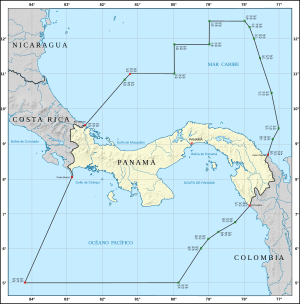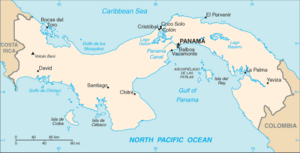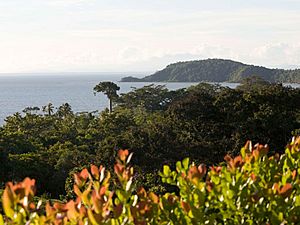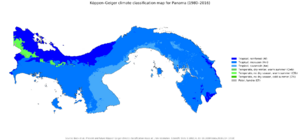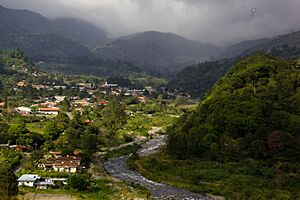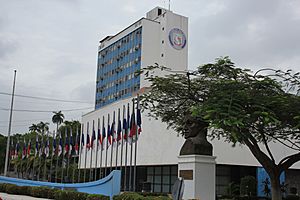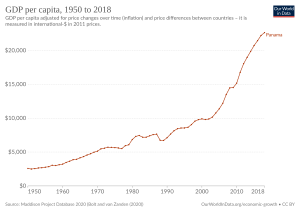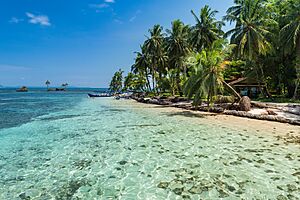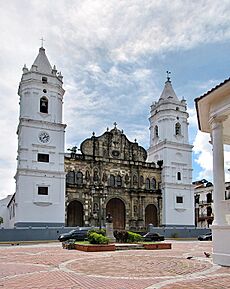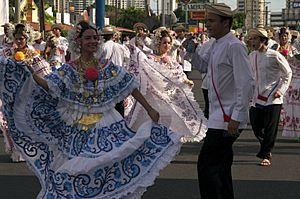Panama facts for kids
Quick facts for kids
Republic of Panama
República de Panamá (Spanish)
|
|
|---|---|
|
|
|
|
Motto: Pro Mundi Beneficio (Latin)
"For the Benefit of the World" |
|
| Capital and largest city
|
Panama City 8°58′N 79°32′W / 8.967°N 79.533°W |
| Official languages | Spanish |
| Recognised regional languages | Guaymí Buglere Emberá Wounaan Kuna Teribe Bribri |
| Ethnic groups
(2020)
|
|
| Religion
(2020)
|
|
| Demonym(s) | Panamanian |
| Government | Unitary presidential republic |
| José Raúl Mulino | |
| Vacant | |
| Legislature | National Assembly |
| Independence | |
|
• from Spanish Empire
|
November 28, 1821 |
|
• union with Gran Colombia
|
December 1821 |
|
• from Republic of Colombia
|
November 3, 1903 |
|
• Current constitution
|
October 11, 1972 |
| Area | |
|
• Total
|
75,417 km2 (29,119 sq mi) (116th) |
|
• Water (%)
|
2.9 |
| Population | |
|
• 2022 estimate
|
4,337,768 (127th) |
|
• Density
|
56/km2 (145.0/sq mi) (122nd) |
| GDP (PPP) | 2024 estimate |
|
• Total
|
|
|
• Per capita
|
|
| GDP (nominal) | 2024 estimate |
|
• Total
|
|
|
• Per capita
|
|
| Gini (2023) | ▼ 48.9 high |
| HDI (2022) | very high · 57th |
| Currency | |
| Time zone | UTC−5 (EST) |
| Date format | mm/dd/yyyy dd/mm/yyyy |
| Driving side | right |
| Calling code | +507 |
| ISO 3166 code | PA |
| Internet TLD | .pa |
Panama is a country in Central America. Its official name is the Republic of Panama. It is most famous for the Panama Canal. Panama borders Costa Rica to the northwest and Colombia to the southeast. It lies between the Caribbean Sea and the Pacific Ocean. Most people in Panama are Roman Catholic.
Contents
Panama's History
Before the 1500s, many different native tribes lived in Panama. Spanish explorers arrived in the 16th century. Panama later became independent from Spain in 1821.
After gaining independence, Panama joined a larger country called Gran Colombia. This union included areas that are now Ecuador and Venezuela. When Gran Colombia broke apart in 1831, Panama became part of the Republic of Colombia.
In 1903, Panama separated from Colombia. The United States supported this separation. This allowed the Panama Canal to be built. The United States Army Corps of Engineers completed the canal between 1904 and 1914.
Later, in 1977, the Torrijos–Carter Treaties were signed. These agreements decided that the United States would give control of the canal to Panama. This transfer happened on December 31, 1999. The land around the canal was returned earlier, in 1979.
Panama's Geography
Panama is in Central America. It has coastlines on both the Caribbean Sea and the Pacific Ocean. It is located between Colombia and Costa Rica. Most of Panama lies between 7° and 10°N latitude and 77° and 83°W longitude.
Its location on the Isthmus of Panama is very important. An isthmus is a narrow strip of land connecting two larger landmasses. Panama controls the Panama Canal, which links the Atlantic Ocean (via the Caribbean Sea) to the Pacific Ocean. Panama's total land area is about 74,177 square kilometers.
The main feature of Panama's land is a chain of mountains and hills. These form the continental divide, separating rivers that flow to the Pacific from those that flow to the Caribbean. This mountain range is called the Cordillera de Talamanca near Costa Rica. Farther east, it becomes the Serranía de Tabasará. The part closer to the Panama Canal is often called the Sierra de Veraguas.
The highest point in Panama is Volcán Barú. This volcano rises to 3,475 meters.
Panama has the most diverse wildlife in Central America. It is home to many species from both North and South America.
Waterways and the Panama Canal
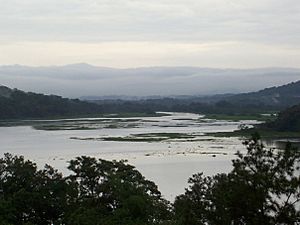
Panama has nearly 500 rivers. Most of them are not easy to travel by boat. Many start as fast streams in the mountains. They then wind through valleys and form deltas near the coast.
The Río Chagres (Chagres River) is in central Panama. It is one of the few wide rivers. It is also a source of hydroelectric power. A dam called the Gatun Dam was built across the Río Chagres. This created Gatun Lake, a huge artificial lake. This lake is a key part of the Panama Canal. When it was built, Gatun Lake was the largest man-made lake in the world. The dam was also the largest earth dam.
The Río Chagres flows northwest into the Caribbean Sea. Other lakes, Kampia and Madden, also get water from the Río Chagres. They provide electricity for the area.
More than 300 rivers flow into the Pacific Ocean. These rivers are longer and flow slower than those on the Caribbean side. The Río Tuira is one of the longest. It flows into the Golfo de San Miguel. It is the only river in Panama that larger ships can use.
Panama's Harbors
Panama's Caribbean coast has several natural harbors. Cristóbal, at the Caribbean end of the canal, has important port facilities. The many islands of the Archipiélago de Bocas del Toro offer a large natural anchorage. They protect the banana port of Almirante. The more than 350 San Blas Islands stretch for over 160 kilometers along the Caribbean coast.
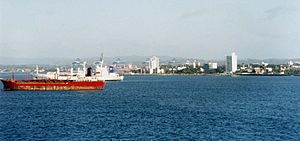
The ports at each end of the Panama Canal are very busy. These are the Port of Cristóbal (in Colón) and the Port of Balboa. They are among the busiest in Latin America for handling shipping containers. The Port of Balboa is large, covering 182 hectares. It has many berths for containers and other ships. It also has large cranes and warehouse space.
The ports in Colón handled over 2.2 million container units in 2009. This made them the second busiest in Latin America.
Panama also has excellent deep-water ports for very large oil tankers. These are at Charco Azul (Pacific side) and Chiriquí Grande (Atlantic side). The Trans-Panama pipeline runs 131 kilometers across the country. It has been moving oil between these ports since 1979.
Panama's Climate
Panama has a tropical climate. This means temperatures are always warm. The air is also very humid. There is not much change in temperature throughout the year. For example, in Panama City, the temperature might be 24°C in the morning and 30°C in the afternoon. It rarely gets hotter than 32°C for long.
Temperatures are a bit cooler on the Pacific side of the country. Breezes often pick up after sunset. In the higher mountains, like the Cordillera de Talamanca, it is much cooler. Frost can even occur there.
Rainfall is what really defines the climate regions. It can range from less than 1,300 mm to over 3,000 mm per year. Most of the rain falls during the rainy season. This usually lasts from April to December. Rainfall is much heavier on the Caribbean side than on the Pacific side. This is partly because of occasional tropical storms nearby.
Panama is one of only three countries in the world that is carbon-negative. This means it takes in more carbon dioxide than it releases into the air. The other two countries are Bhutan and Suriname.
Plants and Animals in Panama
Panama's tropical environment is home to many plants. Forests cover almost 40% of the country. However, deforestation (cutting down trees) is a problem. Tree cover has been cut by more than half since the 1940s.
Farmers grow corn, beans, and root crops in many areas. Mangrove swamps grow along parts of both coasts. Banana farms are found in river deltas near Costa Rica. In many places, a thick rainforest grows from the swamps up the lower mountain slopes.
Soberanía National Park is a great place for birdwatching. More than 525 types of birds live there. It also has many mammals like capybaras and coyotes. You can also find reptiles like the green iguana and amphibians like the cane toad.
In 2022, Panama announced a plan to build a large factory. This factory will make aviation fuel from plants. This will help create fuel with less carbon.
Panama's Government and Politics
Panama is a presidential democratic republic. This means the President of Panama is both the head of the country and the head of the government. Panama has a multi-party system, meaning many different political parties exist. The government handles the executive power. The National Assembly and the government share legislative power (making laws). The judiciary (courts) is separate from the executive and legislative branches.
All citizens 18 years and older can vote in national elections. Elections for the president and lawmakers happen every five years. Judges are chosen by the president. The National Assembly members are elected based on how many votes their party gets in different areas. This allows smaller parties to have a voice. To win the presidential election, a candidate needs the most votes, not necessarily more than half.
Panama's Regions and Provinces
Panama is divided into ten provinces. Each province has its own local government. These provinces are further divided into smaller areas called districts and corregimientos (townships).
There are also six special areas called Comarcas. These are home to different groups of native people.
Provinces
- Bocas del Toro
- Chiriquí
- Coclé
- Colón
- Darién
- Herrera
- Los Santos
- Panamá
- West Panamá
- Veraguas
Comarcas
- Emberá
- Guna Yala
- Naso Tjër Di
- Ngäbe-Buglé
- Kuna de Madugandí
- Kuna de Wargandí
Panama's Economy
Panama's economy is strong and growing. In 2012, only 2.7% of people were unemployed. The country even had a food surplus in 2008. Panama ranked 60th on the Human Development Index in 2015.
In recent years, Panama's economy has grown very fast. From 2006 to 2008, its economy grew by over 10.4% each year. Panama's economy was one of the fastest growing and best managed in Latin America. Experts predicted it would continue to grow quickly.
The project to make the Panama Canal bigger is helping the economy even more. Panama also signed a trade agreement with the United States. This agreement removes taxes on many services.
Even though Panama is considered a high-income country, there are still big differences between rich and poor. This is partly because of differences in education. Between 2015 and 2017, the number of people living in poverty decreased.
Economic Activities
Panama's economy mostly relies on its service sector. This includes things like trade, tourism, and shipping. This is because of Panama's important location.
The Panama Canal is very important for the economy. It brings in millions of dollars from tolls. It also provides many jobs. In 1999, Panama took full control of the Canal after 85 years of U.S. control.
A project to build a third set of locks for the Panama Canal was approved in 2006. This project cost about $5.25 billion. It helps the canal handle even more ships.
Foreign companies are also developing copper and gold mines in Panama. However, some environmental groups are concerned because these projects are in protected areas.
Getting Around Panama
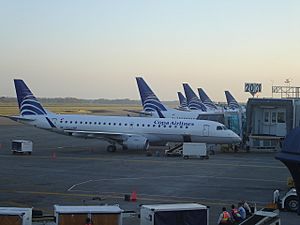
Tocumen International Airport is Panama's largest airport. It is a major hub for Copa Airlines, Panama's main airline. There are also over 20 smaller airfields in the country.
Panama's roads and transportation systems are generally safe. However, driving at night can be difficult in some areas. Traffic drives on the right side of the road. Drivers and passengers must wear seat belts. Highways are usually well-developed. The Pan-American Highway runs through Panama from north to south. It starts at the Costa Rican border but stops before reaching Colombia in an area called the Darién Gap.
Panama City has a good public bus system called MiBus. It also has two rapid transit lines for its Panama Metro. Before MiBus, private buses called "diablo rojos" (red devils) were common. These were old school buses from the United States painted in bright colors. Now, "diablo rojos" are mostly used in rural areas.
Tourism in Panama
Tourism in Panama has grown a lot in recent years. The government offers tax breaks and discounts to foreign visitors and people who retire there. This makes Panama a good place to retire. Because of this interest, more tourist spots have been built.
The number of tourists from Europe increased by 23.1% in the first nine months of 2008. Most European tourists came from Spain, Italy, France, and the United Kingdom. Europe has become a key area for Panama to attract visitors.
In 2012, tourism brought in over $4.3 billion to Panama's economy. This made up 9.5% of the country's total economic output. About 2.2 million tourists visited Panama that year.

Panama's Currency
Panama's official currency is the balboa. However, in practice, Panama uses the United States dollar for all paper money. Panama has its own coins, but U.S. coins are also widely used. Because the balboa is linked to the U.S. dollar, Panama usually has low inflation (prices not rising too fast).
The balboa replaced the Colombian peso in 1904, after Panama became independent. Balboa banknotes were printed only once, in 1941. They were quickly taken out of circulation, earning them the nickname "The Seven Day Dollars." These notes were burned by the new government. U.S. notes have been used in Panama before and since then.
In 2022, Panama's lawmakers approved a bill to make bitcoin and other cryptocurrencies legal. This bill covered using and trading cryptocurrency. It also allowed people to pay taxes with their cryptocurrency. However, in July 2023, the Supreme Court of Justice said the bill could not be enforced.
Panama's People
Panama had an estimated population of 4,337,768 in 2022. In 2010, about 29% of the population was under 15 years old. About 64.5% were between 15 and 65, and 6.6% were 65 or older.
More than half of Panama's people live in the area between Panama City and Colón. Panama's population is mostly urban, with over 75% living in cities. This makes Panama the most urbanized country in Central America.
Ethnic Groups in Panama
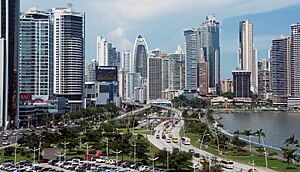
In 2010, Panama's population was made up of different ethnic groups. About 65% were Mestizo (mixed White and Native American). About 12.3% were Native American. Around 9.2% were Black or of African descent. About 6.8% were mulatto (mixed White and Black). And 6.7% were White.
Panama's Native American population includes seven main groups: the Ngäbe, Kuna (Guna), Emberá, Buglé, Wounaan, Naso Tjerdi (Teribe), and Bri Bri.
Most Afro-Panamanians live in the Panama City–Colón area, the Darién Province, La Palma, and Bocas del Toro Province. Areas in Panama City like Rio Abajo and Casco Viejo have a strong Afro-Panamanian influence. Many Black Panamanians are descendants of African slaves brought to the Americas. A second group of Black people came from the Caribbean to work on the Panama Canal.
Panama also has many people of Chinese and Indian descent. They came to work on the canal during its construction. Most Chinese Panamanians live in the province of Chiriquí. Europeans and White Panamanians are a smaller group in Panama. There are also small Arab and Jewish communities, with mosques and synagogues.
Languages Spoken in Panama
Spanish is the official and main language in Panama. About 93% of the population speaks Spanish as their first language. Many people who work in international jobs or for big companies speak both English and Spanish. About 14% of Panamanians speak English. This number is expected to grow because Panama now requires English classes in public schools.
Native languages, like Ngäbere, are spoken in different parts of the country. This is especially true in areas where native groups live. Over 400,000 Panamanians keep their native languages and customs. About 4% of people speak French, and 1% speak Arabic.
Largest Cities in Panama
Here are the 10 largest cities and towns in Panama. Most of Panama's biggest cities are part of the Panama City Metropolitan Area.
|
Largest cities or towns in Panama
City Population |
||
|---|---|---|
| Rank | Name | Pop. |
| 1 | Panama City | 430,299 |
| 2 | San Miguelito | 315,019 |
| 3 | Las Cumbres | 127,440 |
| 4 | La Chorrera | 118,521 |
| 5 | Tocumen | 113,174 |
| 6 | Pacora | 103,960 |
| 7 | Arraiján | 96,676 |
| 8 | David | 81,957 |
| 9 | Vista Alegre | 55,114 |
| 10 | Santiago de Veraguas | 51,236 |
Religion in Panama
Religion in Panama (2015) Catholics (63.2%) Protestants (25%) Adventist (1.3%) Jehovah's Witnesses (1.4%) Mormons (0.6%) Buddhism (0.4%) Judaism (0.1%) No religion (7.6%) Other religions (0.4%)
Christianity is the main religion in Panama. A government survey from 2015 found that 63.2% of the people identify as Roman Catholic. Another 25% identify as evangelical Protestant.
Panama's Culture

Panama's culture is a mix of different influences. It comes from European music, art, and traditions brought by the Spanish. It also blends African and Native American cultures. For example, the tamborito is a Spanish dance with African rhythms and moves.
Dance is a big part of Panama's diverse cultures. You can experience local traditions at many festivals throughout the year. These festivals feature dances and customs passed down through generations. Cities in Panama host live music performances. You can hear reggae en español, reggaeton, haitiano (compas), jazz, blues, salsa, reggae, and rock music.
Handicrafts and Art
Outside Panama City, local musicians and dancers perform at regional festivals. Panama's mixed culture is shown in its traditional products. These include woodcarvings, special masks, and pottery. It's also seen in Panama's buildings, food, and festivals.
In the past, baskets were made for everyday use. Now, many villages earn money by making baskets for tourists.
The Guna people have a unique culture. They are famous for their molas. A mola is a Guna word for blouse. But the term mola now means the beautiful embroidered panels made by Guna women. These panels form the front and back of a Guna woman's blouse. They are made from several layers of different colored cloth. The layers are loosely stitched together using a special reverse appliqué method.
Holidays and Celebrations
The Christmas parade, called El desfile de Navidad, is held in Panama City. This holiday is celebrated on December 25. The parade floats are decorated in Panama's colors. Women wear special dresses called pollera. Men wear traditional montuno outfits. A marching band with drummers entertains the crowds. In the city, a large Christmas tree is lit up, and people gather to sing Christmas carols.
Traditional Food
Panama's food is influenced by many cultures. It includes ingredients and cooking styles from African, Spanish, and Native American traditions. This reflects the country's diverse population. Since Panama connects two continents, it has many tropical fruits, vegetables, and herbs. These are used in local cooking.
The famous "Mercado de Mariscos" (Seafood Market) offers fresh seafood. You can find Ceviche there, which is a popular seafood dish. Small street stalls called kioscos sell Empanadas. These are pastries filled with meat or vegetables, usually fried. Another pastry is the pastelito, which is similar to an empanada but larger.
Typical Panamanian foods have a mild flavor. They are not as spicy as some foods in other Latin American and Caribbean countries. Common ingredients include maize (corn), rice, wheat flour, plantains, yuca (cassava), beef, chicken, pork, and seafood.
Traditional Clothing
Panamanian men's traditional clothing is called montuno. It includes white cotton shirts, trousers, and woven straw hats.
The traditional women's clothing is the pollera. It started in Spain in the 16th century. By the early 1800s, it was common in Panama. At first, servants wore it. Later, women from higher social classes also started wearing it.
A pollera is made of fine cotton or linen. It is white and uses about 13 yards of fabric.
The original pollera has a ruffled blouse worn off the shoulders. It also has a skirt with gold buttons and ruffles. When the skirt is lifted, it looks like a peacock's tail. The designs on the skirt and blouse are usually flowers or birds. Two large matching pom poms (mota) are on the front and back. Four ribbons hang from the waist. Five gold chains (caberstrillos) hang from the neck to the waist. A gold cross or medallion on a black ribbon is worn as a choker. A silk purse is worn at the waist. Earrings (zaricillos) are usually gold or coral. Slippers usually match the color of the pollera. Hair is often worn in a bun. Three large gold combs with pearls (tembleques) are worn like a crown. A high-quality pollera can cost up to $10,000 and take a year to make.
Today, there are different types of polleras. The pollera de gala is a formal dress. It has a short-sleeved ruffled blouse, two full-length skirts, and a petticoat. Girls wear tembleques in their hair. Gold coins and jewelry are added. The pollera montuna is an everyday dress. It has a blouse, a solid-colored skirt, one gold chain, and pendant earrings. Natural flowers are worn in the hair. Instead of an off-the-shoulder blouse, it has a fitted white jacket with shoulder pleats.
Traditional Panamanian clothing is often worn in parades. Men and women perform traditional dances. Women gently sway and twirl their skirts. Men hold their hats and dance behind the women.
Literature and Books
The first writings about Panama date back to 1535. A modern literary movement began in the mid-19th century.
Sports in Panama
In a 2013 survey, 75% of Panamanians said football (soccer) was their favorite sport. Baseball was second at 19%. Boxing was 4%, and gymnastics 2%.
Football is the most popular sport in Panama. The top football league is the Liga Panameña de Fútbol, started in 1988. The men's national team played in the 2018 FIFA World Cup for the first time. They were in Group G with Belgium, England, and Tunisia. They lost all three games and did not move past the group stage.
Women's club football is played in the Liga de Fútbol Femenino. The women's national team played in the 2023 World Cup. They were the last team to qualify. They joined Group F with Brazil, Jamaica, and France. They finished last with three losses but scored three goals against France. Marta Cox scored Panama's first ever World Cup goal.
Baseball is the second most popular sport. The Panamanian Professional Baseball League is the country's professional winter league. It started in 1946. The Panama national baseball team has won one silver and two bronze medals at the Baseball World Cup. At least 140 Panamanian players have played professional baseball in the United States. This is more than any other Central American country.
Basketball is also popular in Panama. There are local teams and a national team that plays internationally.
Other popular sports include volleyball, taekwondo, golf, and tennis. A long hiking trail called the TransPanama Trail is being built. It will go from Colombia to Costa Rica. Panama's women's national volleyball team plays in Central America's AFECAVOL zone.
Other sports are also growing in popularity. These include triathlon, flag football, American football, rugby, field hockey, and softball. Amateur sports like skateboarding, BMX, and surfing are also popular. Panama has many beaches like Santa Catalina and Venao that have hosted surfing events.
Images for kids
-
Vasco Núñez de Balboa, a recognized and popular figure of Panamanian history
-
"New Caledonia", the ill-fated Scottish Darien scheme colony in the Bay of Caledonia, west of the Gulf of Darien
-
1903 political cartoon. The US government, working with separatists in Panama, engineered a Panamanian declaration of independence from Colombia, then sent US warships and marines to Panama.
-
US President Theodore Roosevelt sitting on a steam shovel at the Panama Canal, 1906
-
Construction work on the Gaillard Cut of the Panama Canal, 1907
-
Omar Torrijos (right) with farmers in the Panamanian countryside. The Torrijos government was well known for its policies of land redistribution.
-
US President Jimmy Carter shakes hands with General Omar Torrijos after signing the Panama Canal Treaties (September 7, 1977).
-
The aftermath of urban warfare during the US invasion of Panama, 1989
-
British Foreign Secretary Boris Johnson swapped football shirts with the President of Panama, Juan Carlos Varela in London, May 14, 2018.
-
The Chagres River
-
Colón Harbor, 2000
-
Panama City, Panama's capital
See also
 In Spanish: Panamá para niños
In Spanish: Panamá para niños




